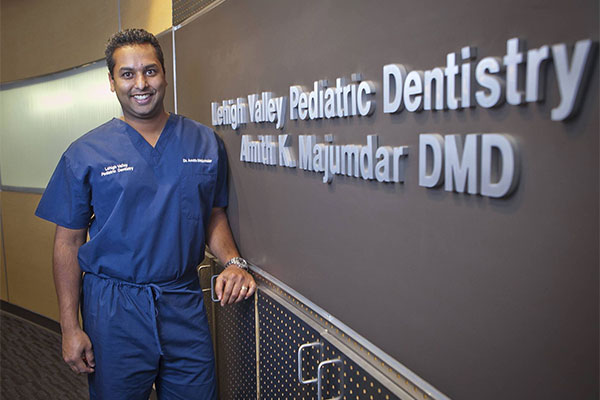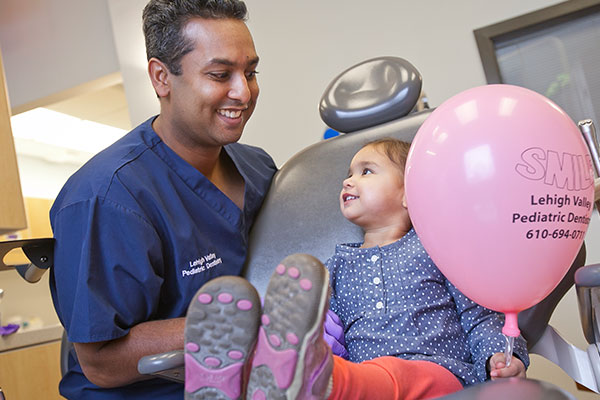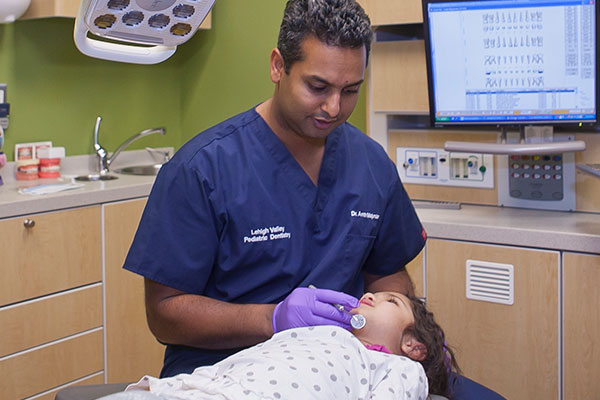WELCOME
Lehigh Valley Pediatric Dentistry is a premier dental facility focused on caring for tots thru teens and those with special needs in a comfortable and caring atmosphere. We believe that a positive dental experience during early childhood will result in good oral habits that will last into adulthood.
WHAT WE DO
Call to schedule an appointment
610-694-0711
24 hour Emergency Service
ABOUT
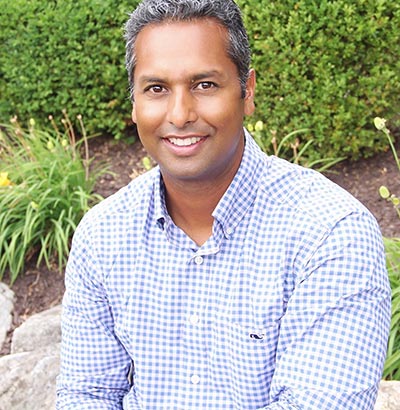
Dr. Amith K. Majumdar is a graduate of Lafayette College where he earned a Bachelor of Science degree in Biology. Dr. Majumdar went on to earn a Doctorate of Medical Dentistry (D.M.D.) from Temple University School of Dentistry. Upon graduation from Temple, Dr. Majumdar continued his education at Temple and completed a one-year Advanced Education in General Dentistry (AEGD) program. While completing the AEGD program, Dr. Majumdar received specialized training in advanced dental technologies, special-needs patient care, and adult restorative dentistry.
Dr. Majumdar went on to complete a two-year Pediatric Dental Residency at the University of Medicine and Dentistry of New Jersey (UMDNJ). At UMDNJ, Dr. Majumdar received extensive training in pediatric dentistry, child development and behavior management.
Dr. Majumdar is a published author and belongs to a number of professional organizations including the American Dental Association, the Pennsylvania Dental Association, the Lehigh Valley Dental Society, and the American Academy of Pediatric Dentistry. Dr. Majumdar is also a faculty member at Lehigh Valley Hospital where he teaches pediatric dentistry to dental residents.
Dr. Majumdar currently lives in Bethlehem with his family.
- A. Kupietzky, A. K. Majumdar , Z. Shey, R. Binder, and P. Matheson. Colony Forming Unit Levels of Salivary Lactobacilli and Streptococcus mutans In Orthodontic Patients. The J of Clinical Pediatric Dent . 30:1, 2005.
- D. S. Tewari, H.A. Qazi, A. K. Majumdar, M. Tewari, S. Uematsu, P. J. Reddy, Z. Truman and O. C. Tuncay. Regulation matrix metallo proteinase-1 (MMP-1) gene expression by NF-KB. Abstract in the J Dent Res . 78:458, 2821, 1999.
- H.A. Qazi, M. Tewari, A. K. Majumdar, O. C. Tuncay and D. S. Tewari . TNF – α mediated programmed cell death ( Apoptosis) in human gingival fiberblasts. Abstract in the J Dent Res . 77: 181, 604, 1998.
- H.A. Qazi, M. Tewari, A. K. Majumdar, O. C. Tuncay and D. S. Tewari . Suppression of IL-1 induced NF-KB and AP-1 geneds by DGLA ( DIHOMO-GAMMA LINLENIC ACID). Abstract in Mol. Bio. Cell. 8: 284,1644, 1997.
- K. S. Wadwa, A. K. Majumdar, C. F. Ferris. S. H. Snyder, W. H. Kuo, G. J. Schwartz, P. J. Pasricha. Caloric feedback inhibition of gastric emptying does not require nitrinergic innervation. Abstract in Gastroenterology . 112: 4, 1997.
- C. F. Ferris, K. S. Wadwa, A. K. Majumdar, S. H. Snyder, W. H. Kuo, G. J. Schwartz, P. J. Pasricha. Targeted disruption of the neuronal NOS gene abolishes the inhibitory response to ganglionic stimulation in the mouse pylorus. Abstract in Gastroenterology, 112: A731, 1997.
- Majumdar, A. K . Allozyme analysis of genetic variation in cabbage butterfly Artogeia rapae . Abstract in the J Penn. Academy of Sci ., Supplemental Issue: 185, 1995 and the Proceedings of the National Conference on Undergraduate Research . 9: 382, 1995.
- Leveter, K. & A. K. Majumdar . Observational study of thecicada-killer wasp Specius speciosus. Proceedings of the National Conference on Undergraduate Research. 8: 933-937, 1994 and abstract in J Penn. Academy of Sci. 67: 185, 1994.
WHY US
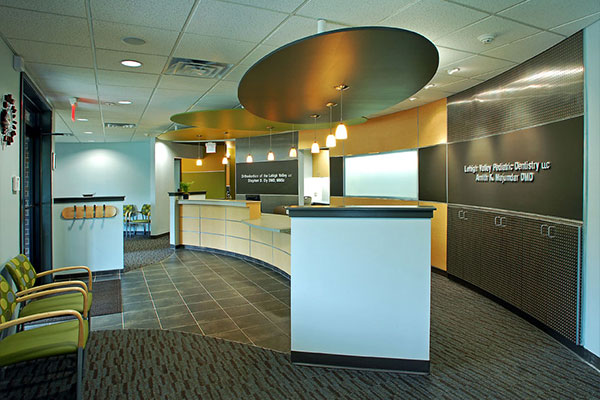
Why a pediatric dentist?
Pediatric dentists complete two or three years of additional specialized training (after the required four years of dental school), which includes study in child psychology, growth, and development. We are also trained and qualified to care for patients with medical, physical, and mental disabilities.
OUR GOAL
We strive to provide an engaging environment in which your child can develop a positive attitude toward dentistry and keep a happy smile. Our team focuses on “coaching” patients and their parents for a lifetime of good oral hygiene and dental health. All education and treatment is provided in a positive and fun environment.
Thank you for visiting our website!
OFFICE TOUR
REVIEWS
First time taking my son. Greeted immediately by front desk with warm welcome and speedy check in. Hygienist was very kid friendly and patient. Dentist was kind and professional.
I have taken my kiddos here for their whole lives, oldest is 18! All 3 of my kids have been treated with care from the front desk to Dr. Amith and his excellent staff who know how to work so well with pediatric patients! This is the only practice I’d ever use or recommend (and we drive a long way from our house to use them!)
My son is non-verbal autistic and they are all so gental. Giving him the time he needs to transition from one thing to another but, also quick to get him out so he doesn't meltdown. I can't say enough good things about Dr. Majumdar and the staff.
Dentist is great! Such a pleasant experience!
I’ve always had a great experience with L.V. Peds Dentistry. My sons have seen Dr. Amith Majumdar for almost 10 yrs. and it’s always been a pleasant experience. And the staff are wonderful. I highly recommend this Dentistry office to anyone.


